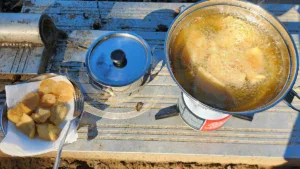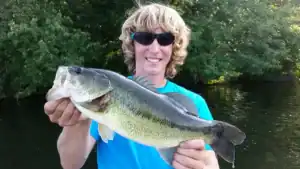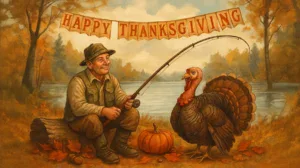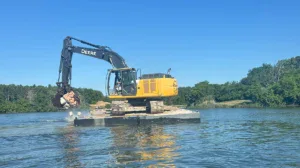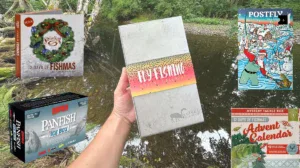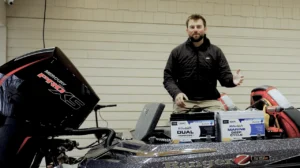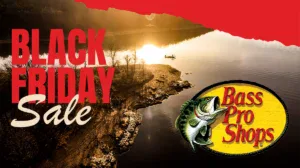Perhaps my tendency for nostalgia is to blame, but I can’t get enough of bank fishing. I grew up walking the banks with my parents and continued even as I landed a job in the fishing industry. It takes me back to a simpler time, but let’s be honest: When done correctly, bank fishing can put you around some enormous bass. I have a pretty bass boat and a bunch of fancy tackle, but I caught a 13-pound bass last year from the bank with a simple Texas rig. This type of fishing proves that anyone can enjoy it and be successful.
There’s one big mistake I’ve noticed some anglers making, however. Now I certainly don’t have all the answers and I’m not always right, but I strongly believe that more careful attention to your casting angles will yield more and much bigger bass. In my opinion, all of this relates to the way pond bass relate to break lines.
I’ve briefly mentioned break lines in the past and there was a little bit of confusion regarding the definition and identification of these very important pond structures. This will clear it all up for you.
Target the highways
I’m not aware of any scientific definition of a break line, so here’s an explanation from a Georgia redneck: If you were to step into a pond from the bank, let’s say the water would be ankle deep. If you were to keep walking towards the middle of the pond, you’d eventually step off of a shelf and find yourself in knee-deep or waist-deep water. That depth change closest to the bank is what I call the break line.
Bass, especially pond bass, use these break lines every day. These small shelves allow them to cruise the perimeter of the pond and strategically ambush unsuspecting prey hanging out in the shallows. In addition, bass also use them for easy travel. Bass always prefer security and they like to be “against” something, whether it’s a dock post, a log or a stump. Many ponds are void of this type of cover, so bass will travel parallel to these break lines because that shelf makes them feel more secure.
So, this begs the question: If the bass use ‘em so much, why in the world are we so hell-bent on casting to the middle of the pond? It always seems like bank anglers want to get close to the middle and boat anglers want to get closer to the shore.
Let’s break that habit, though. Mark my words: You will catch more and bigger bass from shore by targeting these break lines. The biggest pond bass of my life have all come utilizing this strategy.
Okay, I understand. But how do I do it?
Targeting these break lines can be a bit tricky at first, especially if you’re fishing in heavily wooded areas. Essentially, I recommend making 45-degree casts from the bank. As you retrieve your lure, you’ll maximize your time in the most productive strike zone. You’ll bring your lure through the deeper side of the break line and the shallow shelf, just in case a bass is actively pursuing prey in the shallows.
This casting angle can be a bit awkward and often the casts aren’t too pretty. There will be some degree of difficulty, but you’ll get the hang of it in no time. If you’re fishing from a cluttered bank with small openings for your back cast, I strongly suggest investing in a shorter rod. A 6-foot, medium-heavy rod can be your best friend in these situations. It’ll be short enough to allow for more accurate casts in tight quarters, but it’s still long enough for enough leverage on the hookset.
Rig these up before you go
There are three primary rigs I always have rigged when I go bank fishing. That’s certainly not to say other rigs won’t catch fish, but these have consistently produced for me for many years. They’re not the “sexy” stuff that everyone talks about these days, but they’re the triend-and-true rigs that have caught and will catch bass for decades.
Texas-rigged creature bait
I like to have at least one bottom-contact bait rigged up when I’m targeting break lines and of course, the ol’ Texas rig is hard to beat. I can keep it in the strike zone for a long time and it minimizes snags when I’m fishing around any type of cover.
There are a few things to consider, however. I use a pretty lightweight sinker because pond bottoms are notoriously mucky and disgusting—you won’t catch many bass with rotten leaves all over your Texas rig. I most often use a 1/8-ounce tungsten weight and I feel like it gives me the best of both worlds: I can cast it far enough and maintain my bottom contact, but it stays above the layer of muck that you’ll find in most small bodies of water.
Bait-wise, I believe it’s more of a confidence thing than anything else. I always keep a few packs of Zoom Baby Brush Hogs in the door pocket of my truck; a few packs of watermelon red for clearer water during droughts and a few packs of junebug for periods of heavier rain. That’s as complicated as I’ll make it.
Wacky-rigged stick worm
I have no idea why they love it so much, but I’ve quickly learned that pond bass adore a well-placed wacky rig. As long as there’s not a bunch of pond scum of submerged vegetation, you need to have one rigged up.
The formula is simple and affordable: Grab a few packs of VMC Neko Hooks (you’ll thank me later, I promise) and a medium-action spinning rod with 8-pound line. Hook some sort of stick worm in the dead-middle and make a long, 45-degree cast. Let the wacky rig fall on completely slack line and incorporate occasional, subtle twitches with your rod tip. When your line gets heavy or starts to slowly swim to the side, you’re in business. It’s time to set the hook.
My suggested color selection is the same as the Texas rig. Some sort of green color for clear water and a dark color for dirty water. Bass aren’t scientists, so try not to get too spun out over your color choices.
Soft-plastic toad
This is something I’ve picked up on in the last year and it has become a major player whenever I hit the local ponds. Rig up a medium-heavy casting rod with some 65-pound braid and a soft-plastic toad… and hang on. They’ll come off those break lines and completely destroy these things. They’ll be some of the most aggressive topwater bites you’ll see.
I have had a lot of luck with the Zoom Frog and YUM Tip Toad this year. If it’s a little breezy while you’re fishing, I’d probably suggest the Zoom Frog because it displaces a bite more water. If it’s calm, you’ll get plenty of bites on the YUM Tip Toad. You’ll make the same 45-degree casts with these baits.
If you can avoid the common mistake of poor casting angles, you’ll quickly unlock a new dimension of your bank fishing. I’m not saying that my tips are the gospel, but they have certainly produced some enormous bass for me over the years.


